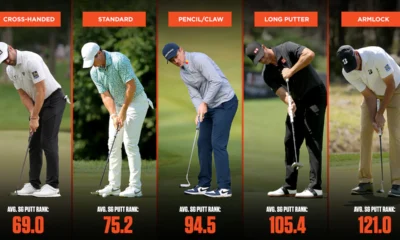Equipment
Mizuno OMOI Putter Review
New putter alert! Mizuno’s OMOI line dropped, and we got our hands on one. These bad boys are all about weight—heavier heads (think 370g+) for a smoother, pendulum-like stroke. The forged steel feels buttery, and the face milling grips the ball just right for a true roll. We tested the Type 1 on a fast green; lag putts were a breeze, and the stability cut down those annoying wobbles. Priced around $300, it’s not cheap, but if your putting’s been a dumpster fire, this might be the fix. Full review coming—stay tuned!
Blog
Fore! Reasons Your Golf Cart Needs a Glow-Up (and How to Do It)

Let’s be honest. We all love the game, the fresh air, the occasional well-struck shot that makes us feel like a temporary Rory McIlroy. But what about the unsung hero of our weekend rounds? The trusty, sometimes rusty, golf cart. For too long, these magnificent machines have been relegated to mere utility. A box on wheels to get us from the pro shop to the first tee and back again. Well, I say no more! It’s time to infuse some personality, some pizzazz, some… us into our golf cart experience. Because a golf cart isn’t just a ride; it’s an extension of our golfing soul.
Think about it. We obsess over driver lofts, putter grips, and the perfect golf fashion ensemble. We want to look good, feel good, and play good. Why should our golf cart be any different? It’s often the first and last impression we make on the course, a mobile clubhouse, and sometimes, let’s be real, a temporary confessional after a particularly brutal triple bogey. So, if you’re ready to ditch the drab and embrace the fab, here are four compelling reasons your golf cart needs a serious glow-up, along with some hacker-approved tips to get you started.
1. Stand Out from the Rough (Literally)
Golf courses are a sea of sameness when it comes to carts. White, beige, maybe a splash of green if you’re lucky. But what if your cart announced your arrival with a flourish? Imagine pulling up to the tee box in a cart that screams “I’m here to have fun and maybe even sink a few putts!” A personalized cart isn’t just about aesthetics; it’s about making a statement. It’s about showing off your golf passion even before you hit your first drive.
Hacker Hack: Start with a custom paint job or some snazzy vinyl wraps. Think bold stripes, a subtle argyle pattern, or even a replica of your favorite golf course’s logo. For the truly committed golf enthusiast, consider some underglow LED lights. Not only do they look cool, but they also make those twilight rounds a whole lot more exciting. Don’t forget custom golf cart wheels and tires; they can completely transform the look and feel of your golf cart.
2. Boost Your On-Course Comfort (and Cool Factor)
Let’s face it, golf can be a long day. Hours spent traversing fairways, searching for wayward shots, and waiting for slow groups. Why not make those hours as comfortable as possible? A basic golf cart seat might suffice, but a souped-up one? That’s next-level golf life. We’re talking about enhancing your overall golf experience.

Hacker Hack: Invest in some premium, upholstered golf cart seats. Think marine-grade vinyl for durability and comfort. Add a custom steering wheel for better grip and a more luxurious feel. And for those scorching summer days, a golf cart fan is an absolute game-changer. You can even install a small cooler to keep your beverages chilled, making you the most popular person in your foursome. Consider a golf cart enclosure for those unexpected rain showers or chilly mornings, keeping you dry and warm.
3. Unleash Your Inner Technophile (and Score Better?)
Who says technology is just for your golf swing analyzer? Your golf cart can be a hub of innovation, making your rounds smoother, more enjoyable, and dare I say, potentially lowering your handicap. From GPS systems to rocking sound setups, there’s a world of golf cart tech waiting to be explored. We’re talking about smart golf accessories for your golf cart.
Hacker Hack: Integrate a golf GPS system directly into your dash. No more fumbling with your phone or rangefinder. Install a Bluetooth sound system so you can enjoy your favorite golf podcasts or pump up the jams between holes. And for the ultimate convenience, consider USB charging ports for your phone or other golf gadgets. Some golf carts even offer built-in ball washers and club cleaners, keeping your golf equipment pristine.
4. Express Your Golfing Personality (and Start Conversations)
Your golf cart is a canvas. It’s an opportunity to showcase your unique golf style and personality. Are you a traditionalist? A wild card? A minimalist? Your cart can reflect that. It’s a fantastic conversation starter and a way to connect with other golfers who appreciate a bit of flair. It’s all about golf cart customization and golf cart accessories that speak to you.
Hacker Hack: Personalize your golf cart with custom floor mats, a unique dash panel, or even a personalized license plate (check your local course rules first!). Add some fun decals or stickers that reflect your golfing sense of humor. A custom golf bag attachment can also add a touch of individuality. The possibilities for golf cart upgrades are endless, from practical additions like a sand bottle for divot repair to purely aesthetic touches.
So, next time you’re about to hop into that plain, run-of-the-mill golf cart, think about the potential. Think about the golf cart accessories, golf cart parts, and golf cart upgrades that can transform it into something truly special. Your golf cart isn’t just transportation; it’s an experience. It’s an extension of your golfing journey, and it deserves to shine as brightly as your best golf shot. Now go forth, hackers, and give your golf cart the glow-up it deserves!
Blog
Why Proper Club Fitting Is the Real Game Changer
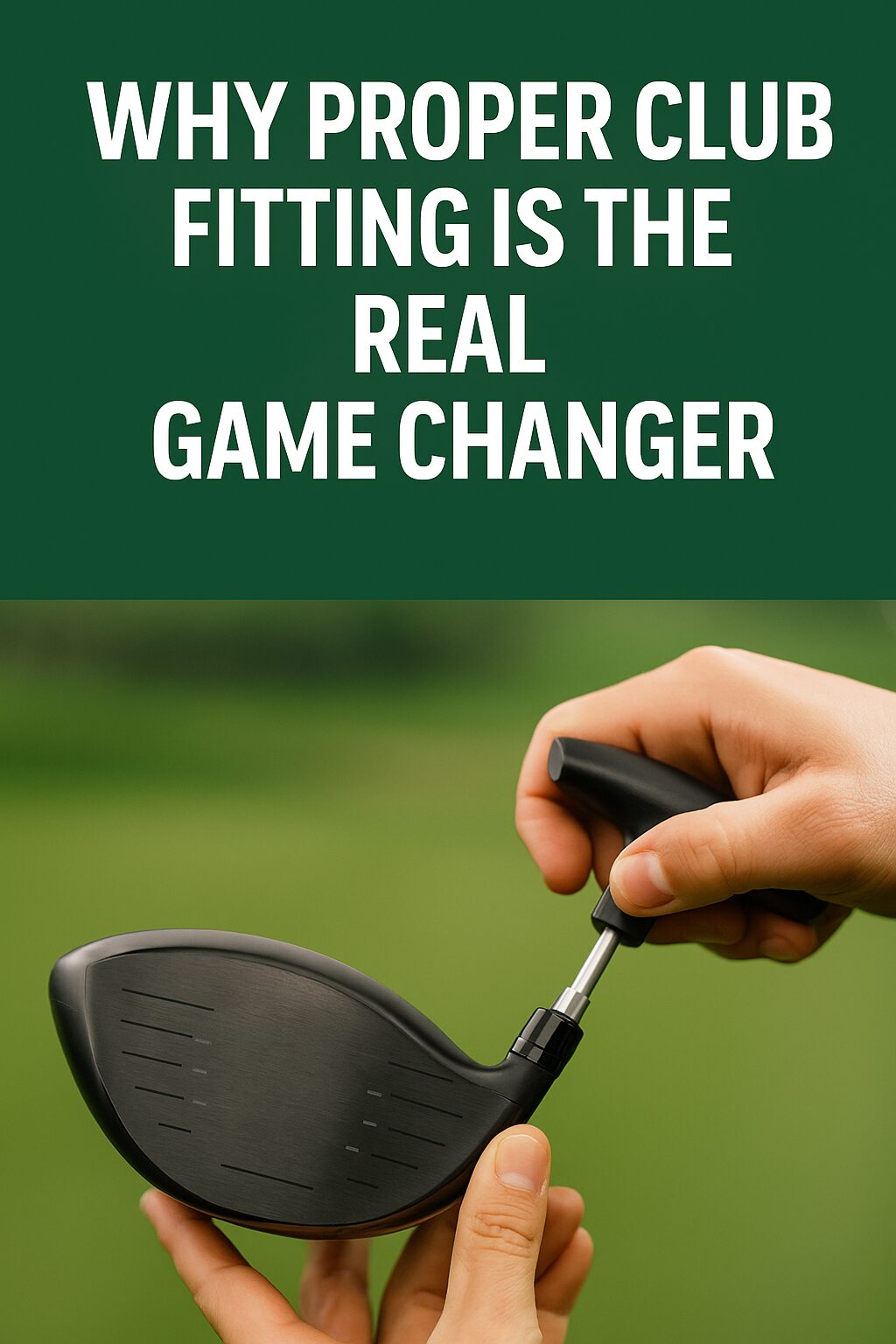
If you’ve ever walked off the 18th green thinking, “It’s not me, it’s the clubs,” well… you might be half right.
As a PGA Professional who’s watched thousands of swings—from scratch players to first-timers—I can tell you that one of the most overlooked keys to better golf is proper club fitting. Not just buying shiny new sticks off the rack, but taking the time to find clubs that are tailored to your swing.
You don’t need a Tour card to get Tour-level precision. Let’s talk about why club fitting matters, what it changes, and how it can truly transform your game from the tee box to the final putt.
The Myth of “Good Enough”
“I’m not good enough to be fit for clubs.”
That’s the most common thing I hear—and it’s completely backwards.
High-handicap golfers have even more to gain from club fitting than low-handicappers. Why? Because the equipment can help you fix ball flight, optimize distance, reduce mis-hits, and build confidence—all without having to reinvent your swing.
Off-the-rack clubs are designed to fit “average” specs. But no two golfers are the same. Length, lie angle, shaft flex, grip size—these all play a massive role in how the club interacts with your body and the ground.
What Happens in a Proper Club Fitting?
At its core, a fitting session is about matching the equipment to your natural swing—not forcing you to swing a certain way to fit the gear.
Here’s what a proper club fitting includes:
1. Interview & Swing Assessment
A certified fitter (or PGA pro like myself) will ask about your current set, ball flight tendencies, common misses, and goals. Then we’ll watch you hit some shots to get a baseline.
2. Launch Monitor Data
Using tools like TrackMan or Foresight, we’ll capture numbers like:
- Ball speed
- Launch angle
- Spin rate
- Club path and face angle
- Carry distance and dispersion
These numbers don’t lie—and they tell us what to tweak.
3. Testing Head & Shaft Combinations
You’ll hit several combinations of club heads and shafts to find what gives you the best performance. One degree of loft or a different shaft flex can make a huge difference.
4. Dialing In Lie Angle & Length
Lie angle affects directional control—too upright, and you might pull shots left; too flat, and you’ll miss right. Club length affects control, consistency, and strike location.
5. Grip Size & Feel
Don’t underestimate this. A grip that’s too thick or too thin can alter your grip pressure and release pattern.
Real Results—Backed by Data
One of my students recently went through a full iron fitting. He was using clubs he bought off the rack 10 years ago. His miss was a push-fade, and he struggled with distance control.
After 90 minutes, a combination of slightly shorter shafts, softer flex, and two degrees more upright lie changed everything. His dispersion tightened by 40%, and he gained an average of 12 yards per club. More importantly—his confidence skyrocketed.
And it wasn’t just him. Across the board, golfers who get fitted:
- Gain more consistent contact
- Reduce directional misses
- Improve distance gapping
- Hit more greens in regulation
- Score better, without changing their swing
The Mental Game Boost
Here’s a secret: it’s not just about numbers. Fitted clubs give you confidence. When you know the tool in your hand is built for you, you swing freer, commit more fully, and stop second-guessing every shot.
Confidence leads to better swings. Better swings lead to better results. It’s a cycle—and it starts with the right equipment.
What About Cost?
Yes, a proper fitting might cost $75–$150 depending on where you go. And yes, custom-fit clubs may be slightly more than what you’d pay at a big box store.
But if you’re already spending time and money on golf, wouldn’t you want to get the most out of it?
A one-time investment in fitting can save you years of frustration—and possibly hundreds spent chasing fixes that won’t work with ill-fitting clubs.
Look—I’ve given thousands of lessons in my career, and nothing changes a golfer’s outlook faster than finally swinging clubs that work with them, not against them.
Whether you’re a 5 handicap trying to fine-tune yardages or a 25 handicap tired of slicing your driver, a proper club fitting can absolutely be a game changer.
You don’t need a new swing—you just need the right tools.
So before you spend another dollar on swing gadgets or tip videos, find your local PGA professional or certified fitter and book a session. Your game (and your sanity) will thank you.
Want more ways to play better without starting over?
Visit ClickItGolf.com every week for practical golf improvement tips, equipment reviews, betting insights, and advice from golfers who live the game every day.
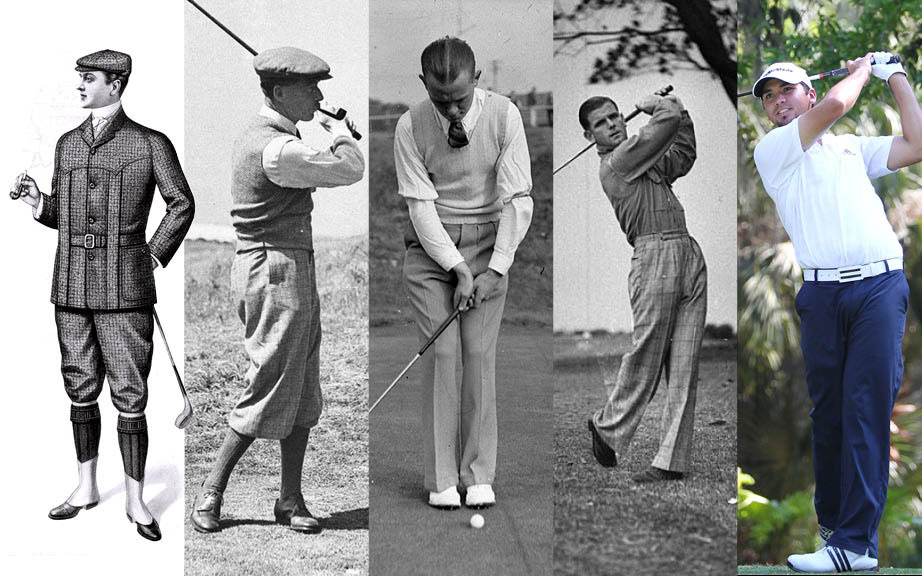
Golf attire has undergone significant transformations over the centuries, evolving from formal, restrictive clothing to today’s stylish, performance-oriented apparel.
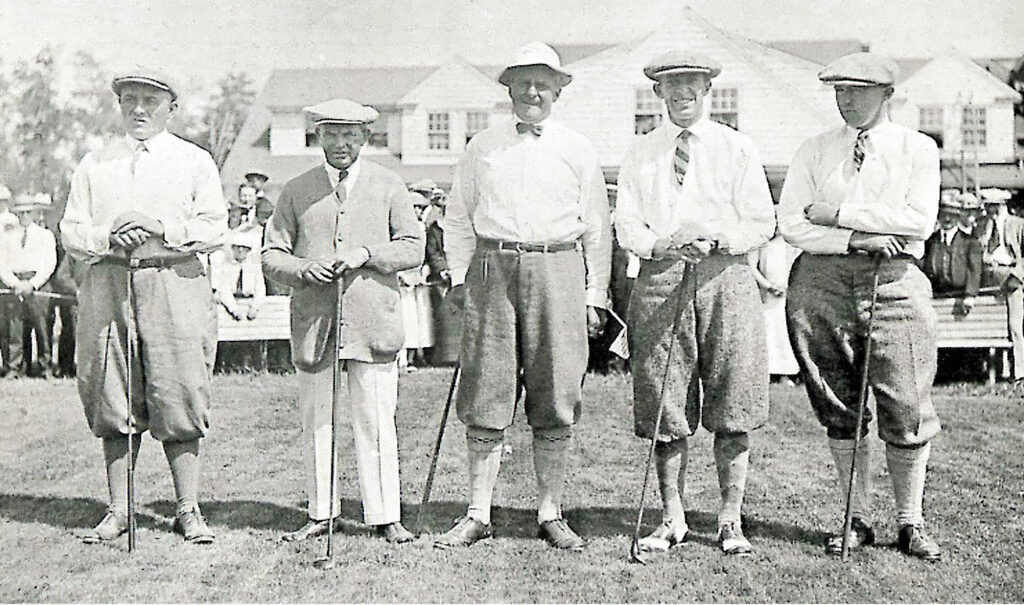
Before 1920
Originating in the cold, windy landscapes of Scotland, early golfers dressed primarily for warmth and protection. Typical attire included full tweed suits, often accompanied by waistcoats and neckties. Knickers, resembling knee breeches, were common, paired with high socks and sturdy leather shoes. Hats varied from pork-pie styles to wide-brimmed designs. While functional against harsh weather, this layered clothing restricted movement, impacting players’ swings.
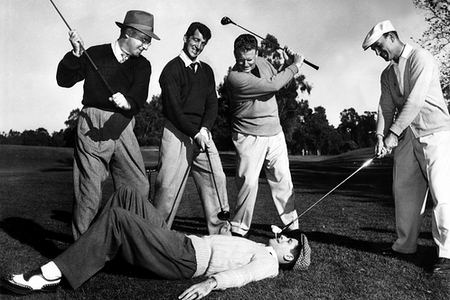
1920s – 1960s
As golf gained popularity in the United States, attire began to reflect contemporary fashion trends. The 1920s introduced plus-fours—knickers extending four inches below the knee—paired with two-toned shirts and, occasionally, ties. In cooler conditions, players opted for knitted wool cardigans or Norfolk jackets. The 1930s saw a shift to lighter fabrics, with short-sleeved knitted shirts and slacks becoming common. Outerwear like the Eisenhower jacket and cardigan sweaters with bell-shaped sleeves allowed greater freedom of movement. Footwear evolved to feature sturdy leather shoes with spikes, enhancing grip on the course.
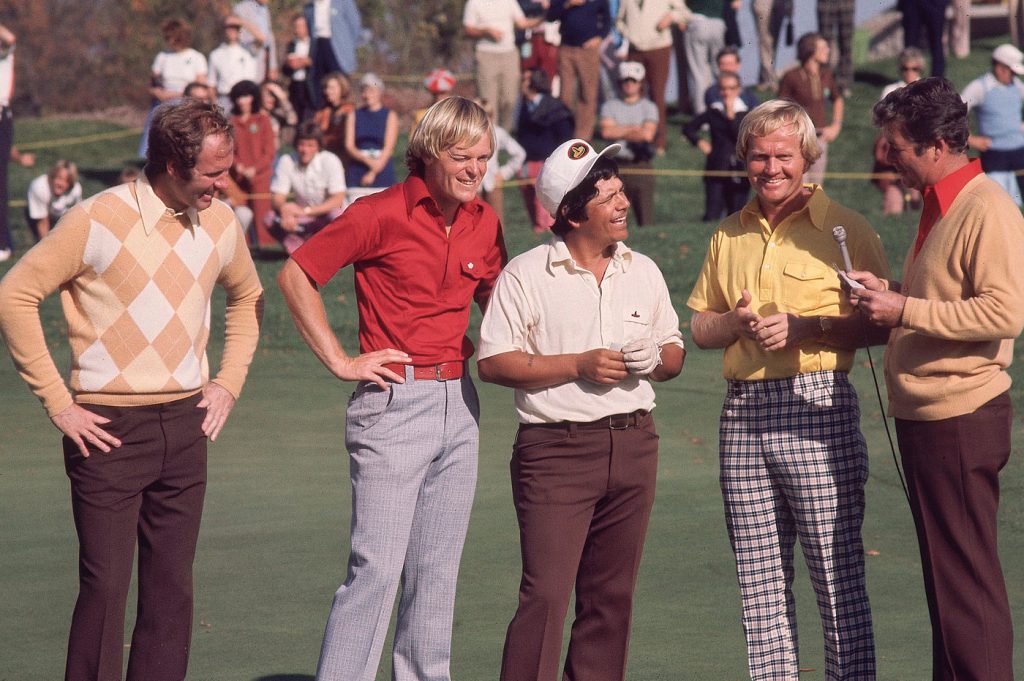
1960s – 2000
The 1960s marked a departure from muted tones, embracing vibrant colors such as greens, blues, and reds. Bold tops contrasted with lighter trousers or shorts, reflecting the era’s fashion sensibilities. Public figures like President John F. Kennedy popularized “Go to Hell” pants—colorful, shorter trousers in eye-catching hues. Recognizing the growing market, brands like FootJoy, Adidas, Nike, Polo Golf Ralph Lauren, and Ashworth launched dedicated golf apparel lines. However, endorsements by celebrity players remained understated during this period.

Since 2000
By the late 1990s, golf had cemented its status among top U.S. sports, leading to lucrative endorsements and a surge in golf club memberships. The game’s evolving dynamics emphasized athleticism, precision, and speed, necessitating advancements in attire. Lightweight, comfortable, and elegant clothing became the norm. Colorful, collared cotton T-shirts paired with tan or khaki shorts or trousers dominated the fairways. Headwear transitioned to pork-pie shapes and baseball caps, while footwear saw a shift from traditional leather to sporty designs from brands like Nike and Adidas.
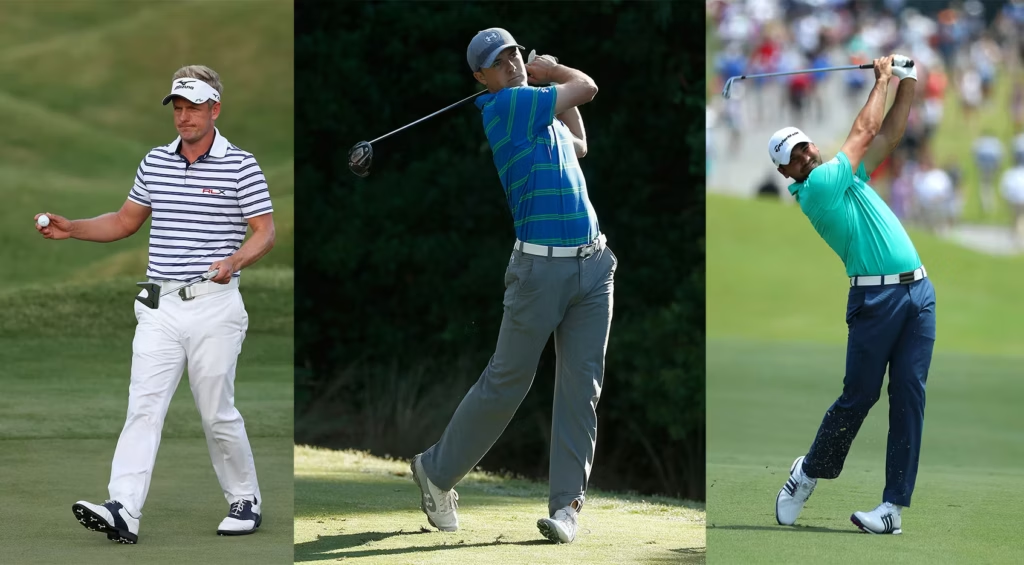
After 2010
The past decade has witnessed a significant shift in golf fashion, influenced by broader cultural trends and technological advancements. The rise of athleisure blurred the lines between sportswear and casual wear, leading to the incorporation of jogger-style pants, hoodies, and stretchy, moisture-wicking materials in golf attire. Brands like Lululemon and Under Armour introduced high-performance golf wear suitable both on and off the course. Collaborations with streetwear labels injected a youthful energy into the sport, attracting a new generation of players. Additionally, sustainability became a focal point, with companies like Reflo producing apparel from recycled materials, reflecting a growing environmental consciousness among consumers. citeturn0search26

This evolution of golf attire mirrors the sport’s journey from its traditional roots to a modern, inclusive game that embraces both style and functionality.
-

 Product Review6 years ago
Product Review6 years agoThe Perfect Practice Putting Mat Review by Jason Tenzer
-

 Blog4 years ago
Blog4 years agoLoophole Rule Offers PGA Tour Pros a Mulligan
-

 Blog4 years ago
Blog4 years ago2021 Buyer’s Guide: The Top 10 Value Golf Balls For Distance & Feel
-

 Blog5 years ago
Blog5 years agoGolf Marriage Counselor
-

 Blog6 years ago
Blog6 years ago9 Biggest Chokes Of The Past Decade
-

 Product Review6 years ago
Product Review6 years agoTHE ADJUSTABLE IRONS: WALKING STICKS GOLF CLUBS
-

 Blog4 years ago
Blog4 years agoWhat Your Golf Clubs Say About You
-

 Equipment6 years ago
Equipment6 years agoOHK Sports Interview by Jason Tenzer












